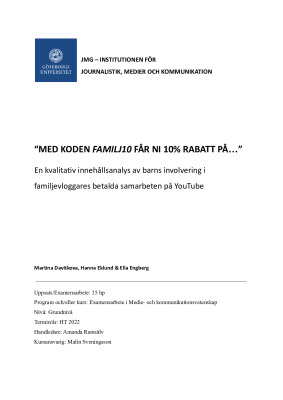“MED KODEN FAMILJ10 FÅR NI 10% RABATT PÅ…”
En kvalitativ innehållsanalys av barns involvering i familjevloggares betalda samarbeten på YouTube
EXECUTIVE SUMMARY
In the early 2000s, the rise of the influencer industry began. An influencer refers to a person with influence and the ability to influence their audience to consume certain products or perform a specific action. The concept of the influencer has enabled individualized marketing where the personal brand includes how ordinary people can conduct profitable activity on their social media channels. These influencers can be found on all different platforms. One of the most popular ones today being YouTube, a platform where individuals can publish their own videos. A popular genre of content are vlogs, meaning blogs in video format. A specific type of vlogs are named family vlogs, where the main content showcases families filming their everyday activities and where the children are frequently exposed. The family vloggers with a large following can also greatly capitalize on the content they publish on YouTube, where exposure of the children is the biggest source of income.
The phenomenon of parents sharing information about their children online and letting them participate in commercial settings has created a major national debate in Sweden about topics regarding ethical and privacy concerns. In 2021, France became the first country to introduce
a law regulating children’s involvement in paid collaborations on their parents’ social media accounts. This only added another depth to the ongoing debate. The topic has also led to research investigating the reasons and motives behind parents including their children in their
social media. Some argue that the motive lies in showcasing parenthood to shape a representation of themselves and build their personal brand on social media. To gain a deeper knowledge about this phenomenon, the aim of this study has been to examine the ways in
which the children are being used in these situations on the social media platform YouTube and how their presence contributes to the emergence of the parent’s self-presentation. The parents investigated are in particular influencers known as family vloggers. The research was
conducted using a qualitative method with a content analysis focusing on two familyvlogger’s published videos with paid collaborations including the children on YouTube.
The theoretical lens of Erving Goffman’s dramaturgical perspective was then used to analyze the findings from the content analysis and to describe how the parent’s self-presentation was created based on the social interaction with the child, the environmental setting and the
personal content shared in the video.
The main results of this study show that the different ages of the children influence how the involvement takes place and fulfills different functions through the verbal and visual communication. Based on the children’s awareness of the situation and ability to communicate verbally, they contribute in different ways to the parents self-presentation. The involvement of the younger child contributes to a positive image of the parent in comparison to the older children where their presence does not contribute as successfully to the impression management of the parent. It also appears that the content presented alludes to authenticity and the portrayal of everyday life, despite its commercial nature.

